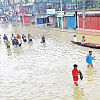Banking the last mile through savings groups

The greatest innovations often emerge from simple solutions. By embracing simplicity, individuals and organisations can foster an environment that encourages creative thinking and ultimately leads to breakthrough innovations.
One such example is the concept of a community savings group, also known as village savings and lending association (VSLA). Typically, a savings group comprises 15-20 self-selected individuals who meet regularly to save money, based on their individual financial capacities. The combined savings are then used to provide loans to the group's members at an affordable interest rate. It allows members access to low-cost financial services with flexible terms as well as a safe location to save their money. The savings and loans of each member are recorded manually in a central ledger or in a memory-based system. Typically, at the end of a set cycle (usually 6-12 months), the accumulated savings and accrued interest are distributed among the members in proportion to the amounts they deposited.
Apart from increasing access to financial services, this savings group also enhances financial literacy among its members simply through participation. It acts as a natural mechanism for people to come together and share necessary information with one another.
Savings groups have played a pivotal role in women's financial inclusion, particularly in Africa. Its rising popularity has led to multiple government interventions along with international NGOs to attain their objectives enlisted in national-level development agendas. A joint study conducted by CARE and SEEP Network in 2018 revealed that there have been 74 government interventions in scaling savings groups by 38 government institutions spanned across 20 countries in Sub-Saharan Africa. According to CARE International, on a global scale, "NGOs and local civil society organisations have mobilised and trained savings groups across 75 countries with an estimated 20 million active members." It is considered to be an economic strengthening strategy for attaining development objectives, mainly safeguarding women's livelihoods, promoting gender equality, social protection, and health.
In Bangladesh, savings groups have been uplifting thousands of women from poverty. Between 2015 and 2020, the number of savings groups reached 2,700 in southwest Bangladesh, with almost 57,000 female members. Among these, 22,554 women took loans, with 80 percent accounting for supporting livelihoods and meeting household needs. In fishing communities, savings group interventions under the ECOFISH project improved women's economic empowerment and skill development, and strengthened their influence in fisheries governance. There was also a decline in gender-based violence (GBV) in these communities. The project's success led to a second phase that improved women's access to microfinance for entrepreneurship development and alternative livelihood investments. Consequently, it created positive spillover effects in non-fishing neighbouring communities.
To take things a little further, infusing technology in a subtle manner can transform saving practices among the last mile population. The mobile money revolution in Bangladesh has been nothing but extraordinary. Domestic fintech players can draw inspiration from foreign organisations to digitise savings groups – for instance, the Ugandan company Ensibuuko. Primarily focusing on women, the company has successfully facilitated developing a formal linkage between savings group members and financial service providers (FSPs) by establishing an ecosystem of bundled services, such as integrating mobile money systems, payment platforms, and financial institutions, as well as enabling end users to access formal financial services and agents to manage e-money and physical floats to process cash-in and cash-out operations.
Pairing e-KYC and mobile money can be a powerful tool to extend financial services to the last mile population. Slow and steady integration of technology among locally led financial instruments such as savings groups increases safety as well as efficiency, and bridges the gap between informal and formal financial services.
Enhancing financial literacy is a process that cannot be rushed; it should be given careful consideration and time to obtain best results. Members must be allowed time to embrace new technologies and overcome their initial scepticism. Applying a human-centred design in fintech solutions is key to gaining consumers' trust and curb the challenges.
A comprehensive study by CARE in 2022 revealed that there are 9,330 savings groups in Bangladesh with 89,455 members in total. Despite the impact it has created in the country, savings groups are not yet part of the formal financial ecosystem. There is no legal framework governing its activities and has also been excluded from the National Financial Inclusion Strategy. Regulations must be drafted so that it improves the overall user experience, rather than create additional pressure on the members that will discourage their participation. Integrating technology in the current infrastructure is most definitely an avenue worth exploring, one that must be looked into by MFS players and relevant authorities.
That said, capitalising on the current growth of savings groups by adopting fintech solutions will accelerate the delivery of financial services in hard-to-reach communities. It must be noted that digitising operations always leaves a trail of information that can be leveraged by technology providers, FSPs and financial institutions. Through concerted efforts, it is possible to bring the last mile population under a formal financial ecosystem and promote sustainable financial practices.
Ameera Fairooz is a postgraduate student at the Faculty of Business Studies in Dhaka University.

 For all latest news, follow The Daily Star's Google News channel.
For all latest news, follow The Daily Star's Google News channel. 










Comments